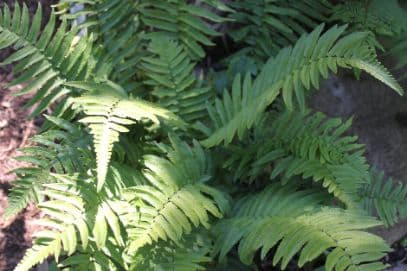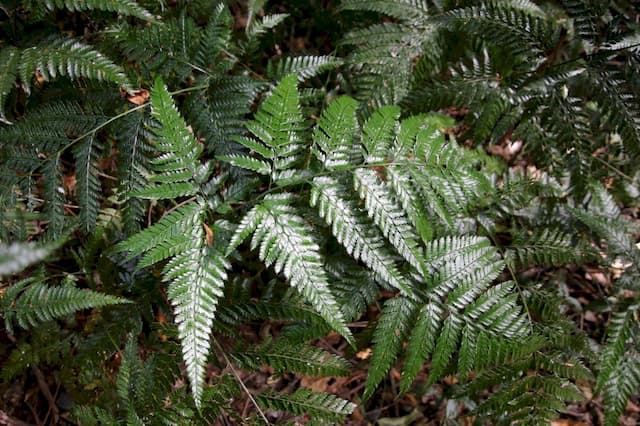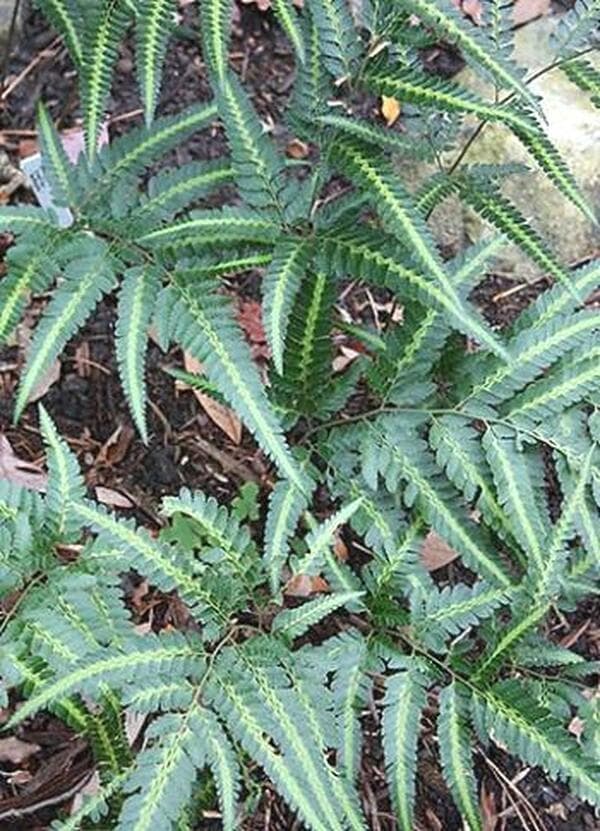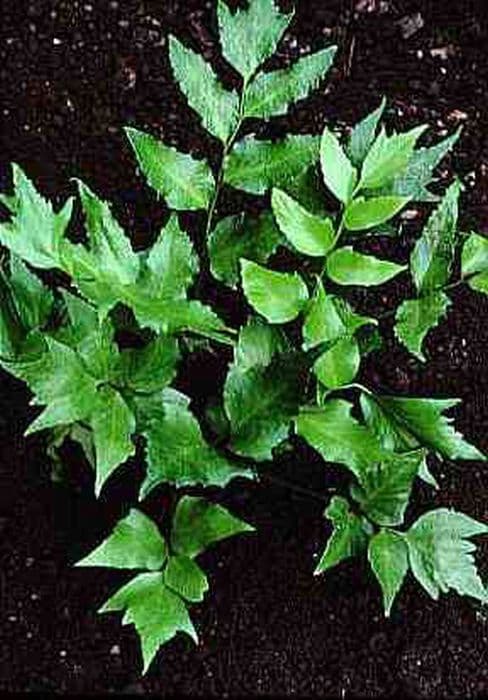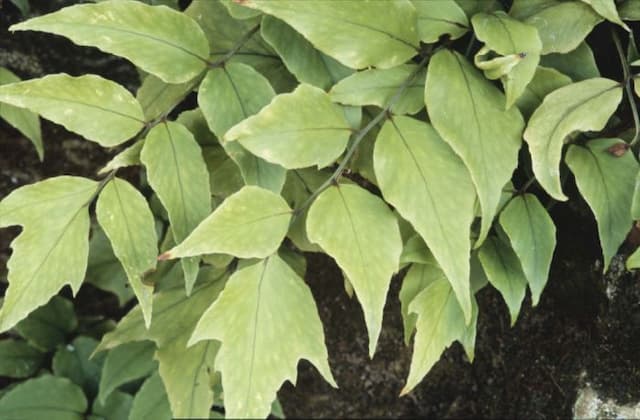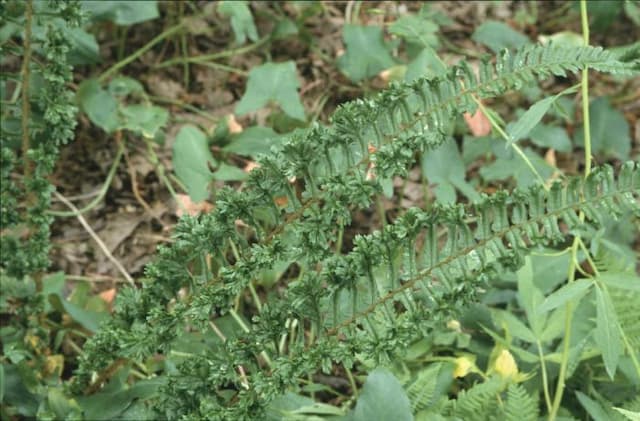Japanese Tassel Fern Polystichum polyblepharum











ABOUT
The plant commonly known as Japanese Tassel Fern is an evergreen fern that boasts a lush and glossy visual appeal. This plant is characterized by its shiny, dark green fronds that have a gracefully arching habit. The leaves are bipinnate, meaning they are divided into numerous leaflets arranged on either side of a central stem, creating a feathery and textured display. Each leaflet is further divided and adorned with small, overlapping scales that give the foliage a slightly rough texture to the touch. On the undersides of the leaflets, one might notice the presence of tiny spores that are used for reproduction. The plant has a symmetrical, vase-like shape, with new fronds unfurling from the center in a circular manner, which resembles tassels, hence the common name. These emerging fronds are often covered in a contrasting golden-brown, fuzzy covering that gradually fades as the fronds mature. The overall impression of the Japanese Tassel Fern is one of elegance and refined texture, making it a favored choice for shaded garden areas where its glossy foliage can add a sense of depth and interest.
About this plant
 Names
NamesFamily
Dryopteridaceae.
Synonyms
Japanese Tassel Fern, Tassel Fern, Korean Tassel Fern.
Common names
Aspidium polyblepharum, Polystichum setosum.
 Toxicity
ToxicityTo humans
The plant known as Japanese Tassel Fern (Polystichum polyblepharum) is not commonly known to be toxic to humans. There is no widespread evidence of toxicity and typically does not cause serious harm if ingested. However, as with many plants, it is not advisable to consume any part of this fern as it is not intended for human consumption, and there may be a risk of gastrointestinal discomfort or allergic reaction in sensitive individuals.
To pets
The Japanese Tassel Fern (Polystichum polyblepharum) is also not known to be toxic to pets. It is generally considered safe around animals, and there are no widely recognized symptoms of poisoning associated with the ingestion of this plant by pets. However, ingestion of non-food items can sometimes lead to gastrointestinal upset in animals, so it is still best to prevent pets from chewing on this or any ornamental plants.
 Characteristics
CharacteristicsLife cycle
Perennials
Foliage type
Evergreen
Color of leaves
Green
Height
2 feet (0.61 meters)
Spread
2 feet (0.61 meters)
Plant type
Fern
Hardiness zones
5-8
Native area
Japan Korea
Benefits
 General Benefits
General Benefits- Aesthetic Appeal: Japanese Tassel Fern adds visual interest to the garden with its dark green, glossy fronds that can give a lush, tropical feel.
- Shade Tolerance: It thrives in shaded areas where other plants might struggle, making it a great option for woodland gardens or darker corners of the yard.
- Low Maintenance: This fern requires minimal care once established, with little need for pruning or deadheading.
- Cold Hardy: Japanese Tassel Fern is resilient in colder climates and can survive in temperatures much lower than many other fern species.
- Soil Adaptability: It can adapt to a range of soil types, though it prefers moist, well-draining soil.
- Drought Resistance: Once established, it can withstand periods of drought, though it prefers consistent moisture.
- Non-Invasive: Unlike some other ferns, Japanese Tassel Fern does not spread aggressively, so it won't take over garden spaces.
- Evergreen: In many climates, it remains green throughout the winter, providing year-round interest in the garden.
- Wildlife Habitat: It can provide habitat and cover for small wildlife, such as birds and beneficial insects.
 Medical Properties
Medical PropertiesThis plant is not used for medical purposes.
 Air-purifying Qualities
Air-purifying QualitiesThis plant is not specifically known for air purifying qualities.
 Other Uses
Other Uses- Japanese Tassel Ferns can be used in terrariums or as a potted plant accent in miniature gardens due to their small size and aesthetic foliage.
- These ferns may serve as a natural mulch under larger plants, as their dense fronds can help retain soil moisture in shaded garden areas.
- In art, the intricate pattern of the fern's leaves can provide inspiration for designs, such as botanical prints or intricate textile patterns.
- Crafters might use the dried fronds of Japanese Tassel Ferns to create natural decor items, such as wreaths or arrangements.
- Photographers and filmmakers can utilize the lush greenery of Japanese Tassel Ferns to set a mood or establish a setting in visual storytelling.
- Due to the slow-growing nature of the Japanese Tassel Fern, it's suitable for use in fairy gardens, providing a sense of scale and fantasy.
- Educational resources can use the plant to demonstrate the life cycle of ferns from spore to mature plant in a classroom setting.
- In floral arrangements, the fronds can add texture and greenery, complementing flowers without taking away from their beauty.
- For relaxation and stress relief, people might place Japanese Tassel Ferns in home office spaces or reading nooks for their tranquil and lush appearance.
- Culinary presentation can be enhanced with the fresh fronds as non-toxic, decorative elements for plating in upscale dining experiences.
Interesting Facts
 Feng Shui
Feng ShuiThe Japanese Tassel Fern is not used in Feng Shui practice.
 Zodiac Sign Compitability
Zodiac Sign CompitabilityThe Japanese Tassel Fern is not used in astrology practice.
 Plant Symbolism
Plant Symbolism- Resilience: Polystichum polyblepharum, commonly known as Japanese tassel fern, thrives in the understory of forests, symbolizing resilience through its capacity to flourish in shaded and competitive environments.
- Protection: With its dense and evergreen fronds, the Japanese tassel fern can be seen as a symbol of shelter and protection, akin to the way it can protect the undergrowth of forests from erosion.
- Longevity: As a perennial plant, the Japanese tassel fern symbolizes longevity and endurance, with some individuals living for many years in the right conditions.
- Elegance: The cascading fronds of the Japanese tassel fern are symmetrical and visually pleasing, thereby representing elegance and aesthetic beauty in a natural setting.
- Tranquility: Often found in tranquil forest settings and shady garden nooks, the Japanese tassel fern comes to represent peace and calmness, where it creates serene atmospheres.
 Water
WaterThe Japanese Tassel Fern should be watered thoroughly once the top inch of soil feels dry, which typically means weekly waterings. During periods of high heat or dryness, this frequency may increase to maintain consistently moist soil. Each watering session should provide enough water to saturate the soil without leaving standing water, which could be roughly around 16 onzes to 32 onzes depending on pot size and indoor conditions. During the winter months, reduce watering but do not let the soil go completely dry. Over-watering can lead to root rot, so ensure good drainage and do not let the fern sit in water.
 Light
LightThe Japanese Tassel Fern thrives best in partial to full shade. It should be placed in an area that receives indirect light or is shaded for most of the day, mimicking its natural understory habitat. Direct sunlight should be avoided, as it can scorch the fronds and cause fading in the vibrant green coloration. A north-facing window or a spot within a room that avoids the harsh midday sun is ideal for this plant.
 Temperature
TemperatureThe Japanese Tassel Fern prefers a cool to moderate temperature range, ideally between 60 Fahrenheit and 75 Fahrenheit. It can tolerate temperatures as low as 50 Fahrenheit but not below, and should be protected from extreme heat that exceeds 80 Fahrenheit. Consistency is key; sudden temperature fluctuations can stress the plant. Its natural environment is typically humid and temperate, so maintaining a stable temperature will promote healthy growth.
 Pruning
PruningPrune the Japanese Tassel Fern to remove any dead or damaged fronds, which helps to prevent disease and maintain its appearance. This task is best performed in mid-spring, just before the new growth begins, ensuring the plant remains vibrant and healthy. Pruning is generally only needed once per year unless additional cleaning of spent fronds is required to keep the plant looking tidy.
 Cleaning
CleaningAs needed
 Soil
SoilJapanese Tassel Fern prefers well-draining, fertile soil high in organic matter with a pH of 5.5 to 6.5. A mix of loamy soil, peat moss, and pine bark is ideal to maintain the necessary acidity and good structure.
 Repotting
RepottingJapanese Tassel Ferns typically need repotting every 2 to 3 years as they outgrow their containers or when the soil begins to degrade.
 Humidity & Misting
Humidity & MistingJapanese Tassel Fern thrives in high humidity conditions, ideally around 60-70%, which is typically found in forest understory environments.
 Suitable locations
Suitable locationsIndoor
Place Japanese Tassel Fern in shade with high humidity.
Outdoor
Plant in part-shade, moist, well-draining area.
Hardiness zone
5-8 USDA
 Life cycle
Life cyclePolystichum polyblepharum, commonly known as Japanese Tassel Fern, begins its life cycle as a spore, which germinates in moist, shady conditions to produce a small, heart-shaped gametophyte. This gametophyte houses both male and female reproductive organs and, upon maturation, produces sperm and eggs. Fertilization occurs when water allows sperm to swim to the eggs, resulting in the formation of a zygote that grows into a new sporophyte. The sporophyte is the familiar leafy fern stage, initially developing as a rosette of fronds from an underground rhizome before unfurling its distinctive, shiny, dark green fronds that can reach up to 1-2 feet in length. As the fern matures, it produces sori—clusters of sporangia—on the undersides of the fronds, which release spores when ripe, continuing the cycle. During its life, Japanese Tassel Fern remains evergreen if not exposed to harsh winter conditions and may live for many years, spreading slowly to form dense clumps.
 Propogation
PropogationPropogation time
Spring to Summer
Propogation: The Tassel Fern, Polystichum polyblepharum, is typically propagated by spore sowing, which is most successful when done in late winter or early spring. The process involves collecting spores from the undersides of mature fronds and sowing them on the surface of a moist, sterile potting mix. The container should be kept at a consistent temperature of around 68°F (20°C) and in indirect light. The surface should remain moist, which can be achieved by covering the container with plastic to maintain humidity. Germination may take several weeks to months, and once the sporelings are large enough to handle, they can be transferred to individual pots. Care should be taken not to disturb the delicate young ferns during transplanting.
